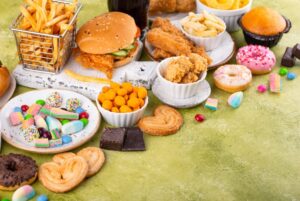Diets fail most often when last-minute hunger meets an empty fridge and a drive-through window. A simple meal-planning routine removes that scenario entirely, delivering steady fat loss without daily will-power battles or crash-diet extremes. Below is a practical template—backed by behavioural research and client case studies—for turning one or two weekly cook-ups into seven days of nutrient-dense meals that tame cravings, break plateaus and protect lean muscle.
1. Why Meal Planning Beats “Will-Power Dieting”
- Decision fatigue: Researchers estimate humans make 200+ food choices daily. Pre-deciding meals frees mental energy for training, work and family.
- Built-in portion control: Pre-portioned containers prevent restaurant-size calorie creep that typically adds 300–500 hidden kcal per meal.
- Saves money: A 2023 USDA analysis found home-prepared meals cost 40 % less than comparable convenience foods (USDA report).
2. Two Meal-Prep Models
| Model | Who It Suits | How It Works |
|---|---|---|
| Batch-Cooking | Busy professionals, parents | Cook bulk proteins, grains and veg once or twice a week; mix-and-match portions each day. |
| Menu Rotation | Variety seekers | Create a 7-day menu with 10–12 recipes; prep two days ahead to keep flavours fresh. |
3. Building a Fat-Loss Plate
Use the ½-¼-¼ rule—half non-starchy vegetables, one-quarter lean protein, one-quarter smart carbs plus a thumb of healthy fat:
- Protein (25–30 g/meal): 93 % lean ground beef, chicken breast, tofu, Greek yogurt.
- Vegetables: asparagus, mixed greens, bell pepper, cauliflower rice.
- Smart carbs: white or brown rice, quinoa, sweet potato, fruit.
- Fats: avocado, extra-virgin olive oil, nuts, seeds.
Macro Starter Guide
- Protein = 1.6 g · kg−1 goal body-weight
- Carbs = 3–4 g · kg−1 (active) or 2–3 g · kg−1 (sedentary)
- Fat = 0.8 – 1 g · kg−1
4. Step-by-Step Batch-Cooking (90-Minute Sunday Session)
- Shop Saturday: Stick to the perimeter—produce, butcher, dairy—plus a few middle-aisle staples (rice, beans, spices).
- Oven at 200 °C / 400 °F: Roast two trays: cubed sweet potato + olive oil; broccoli/cauliflower mix.
- Stovetop proteins: Brown 1 kg lean ground turkey with taco seasoning; simmer 600 g chicken breast in low-sodium broth.
- Rice cooker: 6 cups dry jasmine rice yields 18 cups cooked—portion into 150 g servings.
- Cool & store: Divide food into airtight glass containers labelled Mon–Sun; refrigerate up to 4 days or freeze extras for week two.
5. Handling the Plateau: Trust the Process
A common scenario: first 10–15 lb drop quickly, followed by a multi-week scale stall. Body composition may still be improving as muscle replaces fat and inflammation subsides. Metrics to track beyond weight:
- Waist and hip circumference
- Resting heart-rate variability (HRV)
- School-run stair climb or gym strength numbers
- Energy, sleep quality, digestion
Consistent whole-food intake signals the body that nutrients arrive reliably; over time fat stores—the biological “back-pack”—become needless and are mobilised.
6. Fast “Mini-Prep” for Busy Weeks
Only have 20 minutes? Use a protein + freezer veg + microwavable carb formula:
- Pre-cooked rotisserie chicken (skin removed)
- Frozen stir-fry vegetable blend (steam-in-bag)
- 90-second brown-rice pouch
Season with garlic-powder, chili flakes and a dash of soy-sauce; yields a balanced meal in under five minutes.
7. Common Pitfalls & Fixes
- Boredom: Rotate spice blends (Italian, curry, Cajun) or swap sauces (salsa, Greek tzatziki) to refresh taste without adding empty calories.
- Weekend binges: Keep one “flex meal” planned into macros—e.g., sushi night—to prevent all-or-nothing rebounds.
- Under-eating protein: Add carton egg whites to whole eggs, or mix unflavoured whey into oatmeal.
8. 3-Day Sample Menu (≈ 1 900 cal, 140 P / 190 C / 60 F)
| Meal | Day 1 | Day 2 | Day 3 |
|---|---|---|---|
| Breakfast | Oats + whey + berries | Greek yogurt + honey + almonds | Veg omelette + avocado toast |
| Lunch | Turkey taco bowl | Chicken quinoa salad | Shrimp stir-fry + rice |
| Dinner | Salmon, sweet potato, broccoli | Lean beef chili + side salad | Pesto chicken, whole-wheat pasta, spinach |
| Snack | Cottage cheese + pineapple | Protein smoothie | Apple + 2 Tbsp peanut-butter |
Key Takeaways
- Pre-planned meals bypass decision fatigue and fast-food traps.
- Use batch-cooking or rotating menus to suit taste and schedule.
- Track waist, strength and energy—not scale weight alone—to measure progress.
- Plateaus signal adaptation, not failure; stay consistent and fat loss resumes.
Disclaimer: This article is for educational purposes and does not replace personalised medical advice.
Video Summary
For more evidence-based nutrition and training tips, subscribe to our channel:
https://www.youtube.com/@Vitality-and-Wellness



